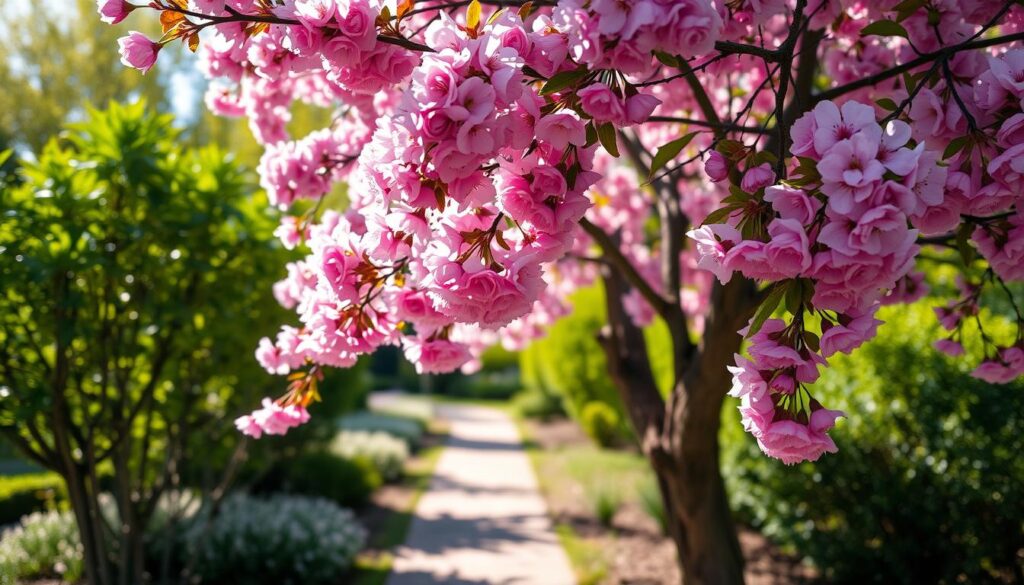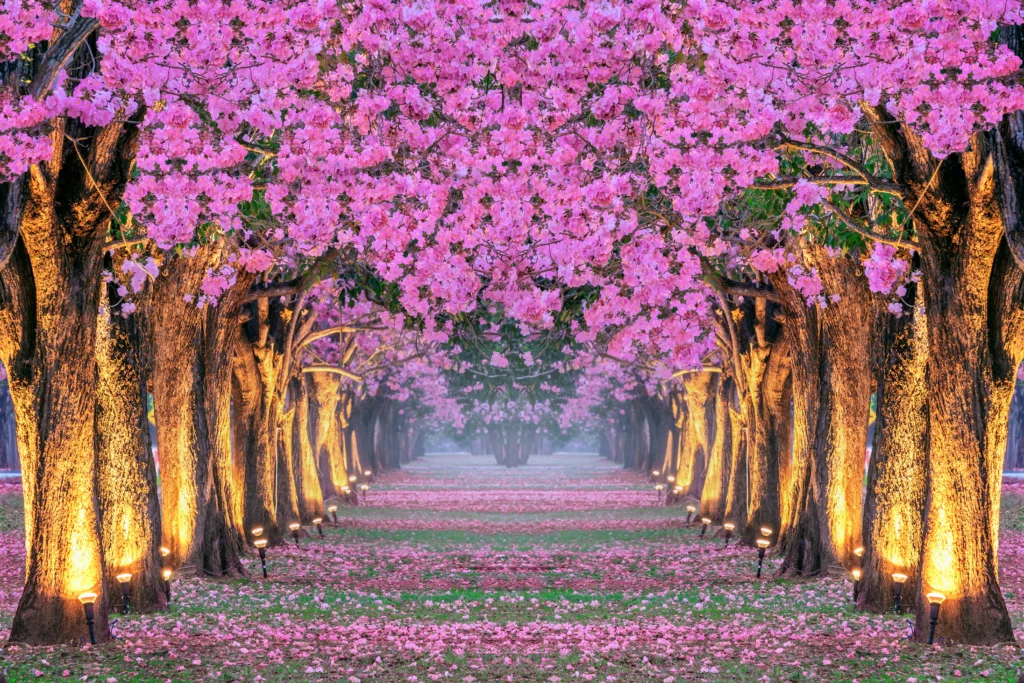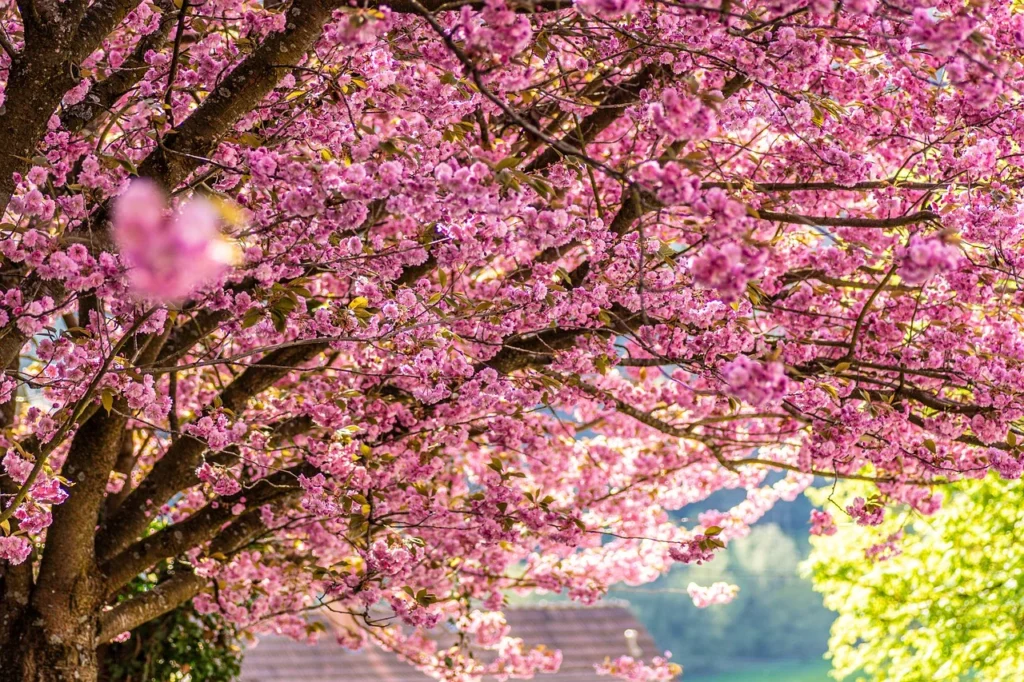Table of Contents
Imagine a tranquil garden that shimmers with soft reds and bright magentas. pink-flowering trees have mesmerized gardeners and nature lovers with their delicate petals fluttering in the wind.
These stunning trees are more than just a visual treat—they have cultural significance, attract wildlife, and can transform even the simplest garden into a magical retreat. Pink flowering trees are a versatile choice for any landscape, from the iconic cherry blossoms that symbolize new life to the hardy crape myrtles that thrive in warm climates. Whether you’re creating a tranquil backyard or making your front yard a focal point, these trees are sure to add charm, beauty, and romance to your outdoor space.

Key Takeaways
- Dive into the delightful world of pink blossoms gracing the finest spring gardens.
- Find out why trees with pink flowers offer more than just aesthetic pleasure.
- Learn how a pink tree can enhance your home landscape effortlessly.
- Discover the cycle of life and beauty in each tree blooms pink flowers as seasons change.
- Uncover tips and tricks for cultivating and caring for your own pink-flowering tree varieties.
Why Pink Flowering Trees Are Ideal for Your Spring Garden
Adding pink flowering trees to your garden design makes it more beautiful. They add a lively spring color to your yard. These trees also make your space feel welcoming with their colors and scents.
They are perfect for making your garden look stunning. Whether you’re starting fresh or updating your yard, pink trees bring beauty and benefits.

The Charm of Pink Blossoms in Landscape Design
Landscape experts say pink trees turn ordinary gardens into stunning views. The pink flowers contrast nicely with green leaves. This makes your garden look even better.
Benefits of Adding Trees With Pink Flowers to Your Garden
Research shows colorful gardens like pink ones can raise your home’s value. They also make your space feel calmer and happier. Pink trees help create a peaceful garden atmosphere.
| Benefits | Description |
|---|---|
| Aesthetic Appeal | Enhances visual interest and complements existing garden elements, contributing to a picturesque landscape. |
| Increased Property Value | Colorful landscapes are often appraised higher due to their enhanced curb appeal. |
| Psychological Well-being | Being around vibrant plants like pink flowering trees has shown to reduce stress and improve mood. |
Pink flowering trees do more than just look good. They improve your life quality. They ensure your garden is a colorful delight every spring, blending beauty with usefulness.
Understanding the Blooming Cycles of Pink Flowering Trees

When planning your garden, knowing the blooming cycles of pink flowering trees is key. These cycles affect your garden’s beauty and upkeep all year. They help create a garden that stays colorful with seasonal blooms all year.
Every pink flowering tree blooms differently. Some start in early spring, while others bloom later. This staggered blooming keeps your garden colorful all the time. Here’s a guide to help plan your garden’s flower displays:
- Initial Blooms: Early spring brings the first flowers, perfect for ending winter’s chill.
- Peak Blooms: Late spring sees many trees in full bloom, with lots of pink flowers.
- Late Season Blooms: Some trees bloom again in early summer or late fall, depending on where you live and the weather.
Remember, your local weather affects these blooming times. Changes in temperature and weather can make trees bloom earlier or later. Good garden planning should account for these changes to keep your garden looking great all season.
Planting different trees that bloom at different times creates a changing garden display. This adds beauty and color to your garden all season. It also makes your garden a lively, colorful place.
Tree Blooms Pink Flowers: A Closer Look
When spring comes, gardens burst into life with pink tree varieties. These trees show off stunning blossoms that make every landscape brighter. But what makes these flowers so special? Let’s explore the unique charm and blooming traits of these floral wonders.
What Makes the Pink Blossom So Captivating?
Pink blossoms are not just beautiful to look at. They also bring joy and calmness. Studies show that pink has a soothing effect. This makes pink trees perfect for places meant for relaxation and quiet thought.
Common Characteristics of Trees That Flower Pink
Pink flowering trees have certain traits that make them stand out. These include the size and shape of their flowers and the best places to grow them. Knowing these traits helps gardeners choose the right trees for their gardens.
| Pink Tree Varieties | Blossom Size (avg.) | Preferred Habitat |
|---|---|---|
| Cherry Blossom | 1.5 inches | Temperate |
| Crabapple | 2 inches | Temperate, Sunlit Areas |
| Eastern Redbud | 1 inch | Woodland Edges |
Learning about pink tree varieties adds to your gardening knowledge. It helps you create a garden that blooms beautifully every spring. Adding these stunning blossoms to your garden will surely impress everyone.
Caring for Your Pink Flowering Trees
To keep your pink flowering trees looking great, you need to know about tree care, soil preparation, and pruning trees. Here’s how to make sure your pink blossoms are the best in the neighborhood.
Ideal Soil Conditions for Pink Blossom Trees
Good tree care starts with the right soil preparation. The soil should feed the roots and keep the tree healthy. It should be well-draining, fertile, and slightly acidic.
Adding organic matter every year can make the soil even better. This helps your tree grow strong and bloom brightly.
Pruning Tips for Pink Flowering Species
Pruning trees the right way can make your pink blooms better. Prune in late winter or early spring to help the tree bloom more. This also keeps the tree looking good.
Take out dead or tangled branches. This lets more sunlight and air get to the tree. This helps prevent diseases.
| Task | Best Season | Benefits |
|---|---|---|
| Soil Testing | Fall | Determines need for amendments |
| Adding Organic Matter | Early Spring | Improves soil fertility and structure |
| Pruning | Late Winter | Promotes growth and airflow |
| Regular Watering | Summer | Supports bloom development |
Top Picks: Pink Flowering Dogwoods
Looking for a standout feature for your garden? The pink flowering dogwood is perfect for Florida’s warm weather. These trees are known for their beauty and ability to thrive. They’re a top pick for gardens, especially in Florida’s unique climate.
Pink flowering dogwoods add beauty to any space. In spring, their pink flowers are a stunning sight. They’re great for Florida gardens because they look good and adapt well to different conditions.
- Breathtaking spring blooms that add color and vibrancy to your garden
- Compact size, making them ideal for both small yards and larger landscapes
- Durable and can withstand Florida’s climate variations
Adding pink flowering dogwoods to your garden makes it more beautiful and diverse. They attract birds and butterflies, bringing life to your garden. They look great alone or with other trees, adding depth and sustainability.
Adding pink to your garden with these trees makes it lively and beautiful. They’re perfect for Florida’s weather, making them a favorite among gardeners.
Embrace the Elegance of Weeping Cherry Trees
As spring arrives, weeping cherry trees bloom with beautiful pink flowers. These trees are known for their stunning, cascading branches and vibrant blossoms. They can turn any garden into a breathtaking sight.
Aesthetic Appeal of Weeping Cherry Trees in Gardens
Weeping cherry trees stand out with their unique shape and pink blossoms. They can be the main attraction in big gardens or add beauty to small spaces. Their beauty is not just in their looks but also in their short-lived nature, symbolizing life’s fleeting beauty.
How to Grow a Healthy Weeping Cherry
To keep your weeping cherry tree healthy, follow these tips:
- Location: Pick a spot with full sun to partial shade. Weeping cherry trees bloom best with at least six hours of sunlight a day.
- Soil: Plant in well-draining soil to avoid root rot. Adding organic matter can make poor soils better for your tree.
- Watering: Water regularly to help roots grow strong. But don’t overdo it. Let the soil dry a bit between waterings.
- Pruning: Prune in late winter or early spring. This shapes the tree and removes dead or crossing branches. It keeps the tree healthy and promotes better blooms.
With the right care, your weeping cherry tree will brighten your garden. It will become a beloved part of your spring landscape, blooming with vibrant pink flowers every year.
Exotic Beauties: Hong Kong Orchid Trees
Imagine stepping into a landscape painted with the vivid hues of the hong kong orchid tree. It’s famous for its dazzling pink blooms. These exotic trees are a treat for the eyes during the blooming season. They also add a luxurious feel to your garden with their large, broad leaves.
The hong kong orchid tree comes from South East Asia. It’s known for its large, orchid-like flowers that seem to float in its green canopy. These exotic trees love full sun and can grow up to 20 feet tall. They spread out, creating a lavish, umbrella-like coverage.
Despite their tropical roots, they’re surprisingly tough in different climates. This makes them a great choice for many gardeners.
From mid-fall to early spring, the pink blooming spectacle is stunning. It attracts both local wildlife and people. The blooms, ranging from deep magenta to light pink, can be up to five inches wide. They add a beautiful blush of color to most gardens.
- Maintenance: Minimal pruning required; highly resistant to pests and diseases.
- Water Requirements: Moderate; drought tolerant once established, but regular watering enhances blooming.
- Soil: Adaptable to most soil types; prefers well-drained fertile ground.
For anyone wanting to add a touch of tropical paradise to their garden, the hong kong orchid tree is perfect. It combines beauty with practicality. It’s a must-have for both new and experienced gardeners looking to create a memorable outdoor space.
Pink Blooms Under the Sun: Desert Willow Tree
Looking to brighten up your garden? The desert willow tree (Chilopsis linearis) is a great pick. It’s native to Texas and the arid Southwest. This tree is known for its vibrant pink flowers and its ability to grow well in tough conditions.
The Desert Willow’s Unique Adaptations
The desert willow tree is perfect for dry areas. It has a deep root system to find water underground. Its narrow leaves also help it save water, making it very drought-tolerant.
In the hottest months, it blooms with pink flowers. These flowers last all summer, even when other plants are struggling.
Maintenance Tips for Desert Willow Trees
Caring for a desert willow tree is easy, thanks to its toughness. It needs full sun and soil that drains well to avoid root rot. Pruning it in late winter keeps it looking good and encourages more blooms.
Water it deeply but not too often. This helps it grow strong roots, just like in its natural habitat. Follow these tips, and your desert willow will bloom beautifully every year.
Crepe Myrtle: The Southern Staple
The crepe myrtle is a key part of southern landscapes. It’s loved for its long blooming season and bright pink flowers. This tree truly captures the South’s spirit, thriving in warm weather and adding color and beauty all summer long.
Crepe Myrtle stands out because it’s so adaptable. It’s not just a beautiful tree; it fits into many landscape styles. Whether it’s the main attraction or part of a bigger design, it makes gardens look great.
- Resilient nature perfect for southern climates
- Their long blooming season stretches from late spring through early fall.
- Ideal for creating vibrant hedges and borders
Adding a crepe myrtle to your garden means more beauty and interest all season. Its blooms are stunning and draw in butterflies and bees.
Crepe myrtles are easy to care for but need some basics like sunlight, water, and occasional pruning. By taking care of them, your garden will bloom beautifully.
Spring Unfolds With the Okami Cherry Blossom Tree
As winter fades, the Okami cherry blossom tree welcomes spring. Its pale pink blossoms open to the sun’s warmth. This tree is a symbol of Japanese heritage, each bloom whispering tradition and beauty.
The Okami cherry blossom stands out with its vibrant, early blooms. Its richer color sets it apart from others, making it a favorite for spring displays.
History and Heritage of the Okami Cherry Blossom
The Okami cherry tree is deeply rooted in Japanese traditions. It plays a key role in Hanami, the ancient art of enjoying flowers. These trees teach us to cherish life’s brief moments.
Planting and Care for Okami Cherry Blossoms
Adding an Okami cherry blossom tree to your garden is a beautiful choice. It needs well-draining, fertile soil and full to partial sun.
| Activity | Spring | Summer | Autumn | Winter |
|---|---|---|---|---|
| Planting | X | |||
| Pruning | X | |||
| Fertilizing | X | |||
| Watering | Regularly | Regularly | Moderate | Minimal |
Adjust your gardening to the seasons to keep your Okami cherry blossom tree thriving. Plant in spring and prune in autumn. Fertilize in summer to prepare for another stunning spring display.
Conclusion
Our journey through the most exquisite pink blossoms of spring has come to an end. Now, you know how these stunning trees can make your garden vibrant. Whether it’s the romantic weeping cherry, the resilient desert willow, or the southern charm of the crepe myrtle, each adds a unique touch.
These trees are more than decorations; they symbolize spring’s rebirth and vitality. By adding these pink-flowering trees to your garden, you create a magical outdoor space. It not only lifts your spirits but also helps your local ecosystem.
With the knowledge from this article, you’re ready to care for these botanical wonders. Remember, planting a tree makes your environment greener and more lively.
We encourage you to see the beauty of these pink blossoms as more than just a sight. They connect us deeply with nature. Let their beauty inspire you to create your own paradise.
As these trees bloom, may your garden show the power of nature’s colors. Enjoy the beauty of your garden, and let the pink blossoms be its highlights.
FAQ
What are some popular trees that bloom pink flowers suitable for a spring garden?
Popular pink-blooming trees for spring gardens include the weeping cherry and crabapple tree. The okami cherry blossom tree and hong kong orchid tree are also favorites. Pink flowering dogwood, desert willow tree, and crepe myrtle trees add beauty to any garden.
Why are pink flowering trees often recommended in landscape design?
Pink flowering trees add a soft, whimsical touch to landscapes. They create a focal point and increase property value. Their vibrant blossoms also help reduce stress, making outdoor spaces more appealing and peaceful.
When planning a garden, why is it important to understand the blooming cycles of pink flowering trees?
Knowing when pink flowering trees bloom is key for a garden full of color. Different trees bloom at different times. Planning with these cycles in mind ensures a continuous display of color in your garden.
Are there any common characteristics shared by trees with pink blooms?
Yes, trees with pink flowers often have similar leaves and petal arrangements. They also prefer similar habitats. This information helps ensure these trees thrive in your landscape.
How do you properly care for pink flowering trees?
To care for pink flowering trees, plant them in well-draining, fertile soil. Regular pruning promotes healthy growth and blooms. Each tree species has specific care needs, so it’s best to follow guidelines for your tree.
What makes the pink flowering dogwood a top pick for gardens, particularly in Florida?
The pink flowering dogwood is loved for its stunning spring display and vibrant fall foliage. It thrives in Florida’s climate and is disease-resistant, making it a beautiful choice for Southern gardens.
Why are weeping cherry trees so valued in garden aesthetics?
Weeping cherry trees are prized for their poetic beauty and cascading pink blossoms. Their unique shape and cultural significance from Japanese traditions make them a cherished garden addition.
What contributes to the exotic appeal of Hong Kong orchid trees in spring gardens?
Hong Kong orchid trees have large, intricate blooms that resemble orchids. Their impressive display and tropical foliage offer a stunning spectacle, making them a unique choice for gardeners.
How does the desert willow tree adapt to arid conditions, such as those in Texas?
The desert willow tree has a deep root system and is drought-tolerant. It copes well with scarce water and high temperatures while providing beautiful pink blooms, making it ideal for Texas landscapes.
What makes the crepe myrtle a staple in Southern landscapes?
The crepe myrtle blooms profusely throughout the summer. It withstands heat and humidity in the South with minimal care, making it a staple in Southern landscapes.
Can you tell me more about the cultural significance of the Okami cherry blossom tree?
The Okami cherry blossom tree holds significant cultural meaning, especially in Japan. The annual Sakura festival celebrates the beauty of cherry blossoms. This significance is embraced worldwide, symbolizing renewal and the fleeting nature of life.
What are the best conditions for growing an Okami cherry blossom tree?
To grow an Okami cherry blossom tree, plant it in well-drained soil with full sun. Protect it from harsh winds and water carefully. Pruning and regular maintenance support its health and blooms.

